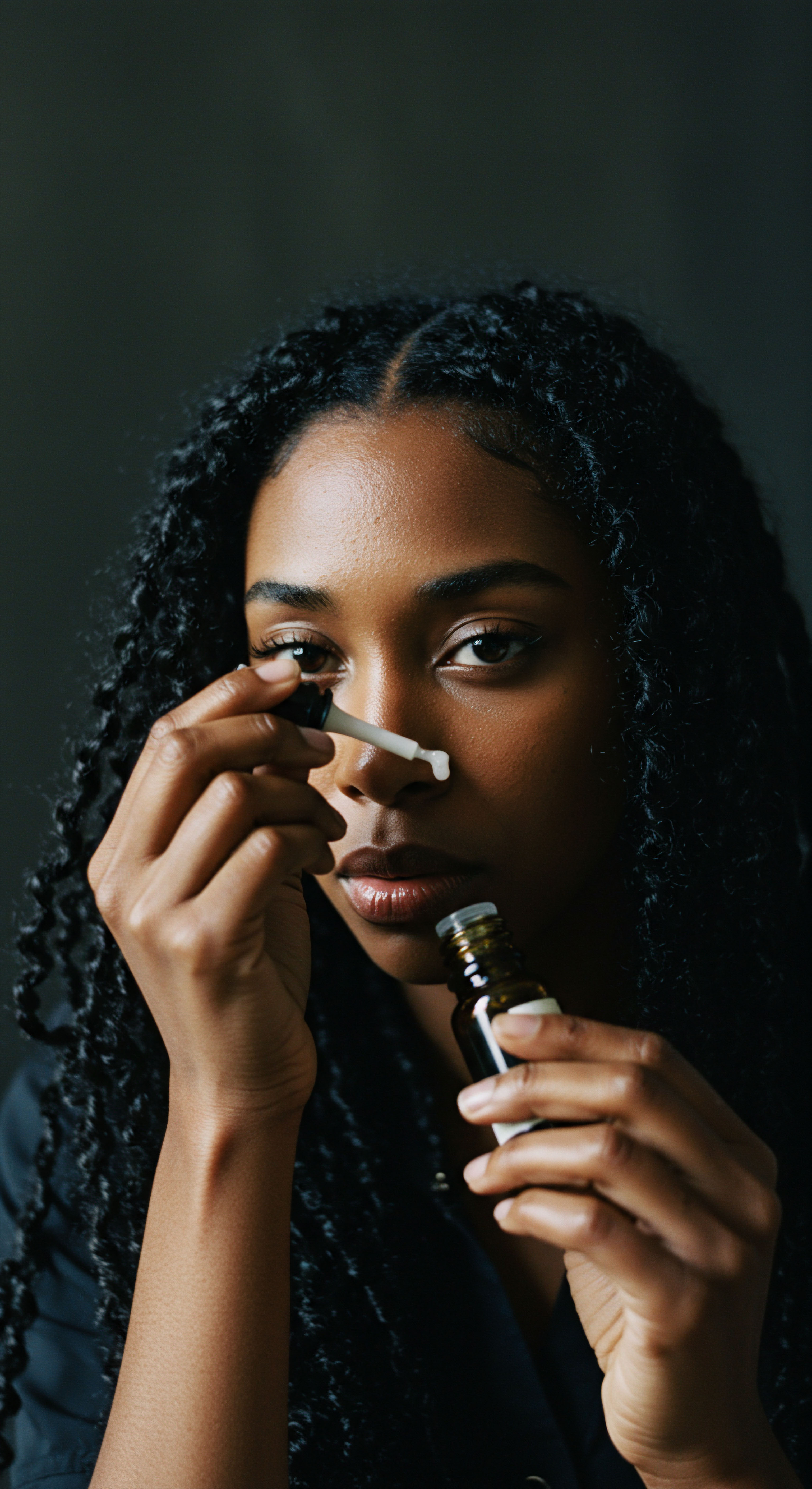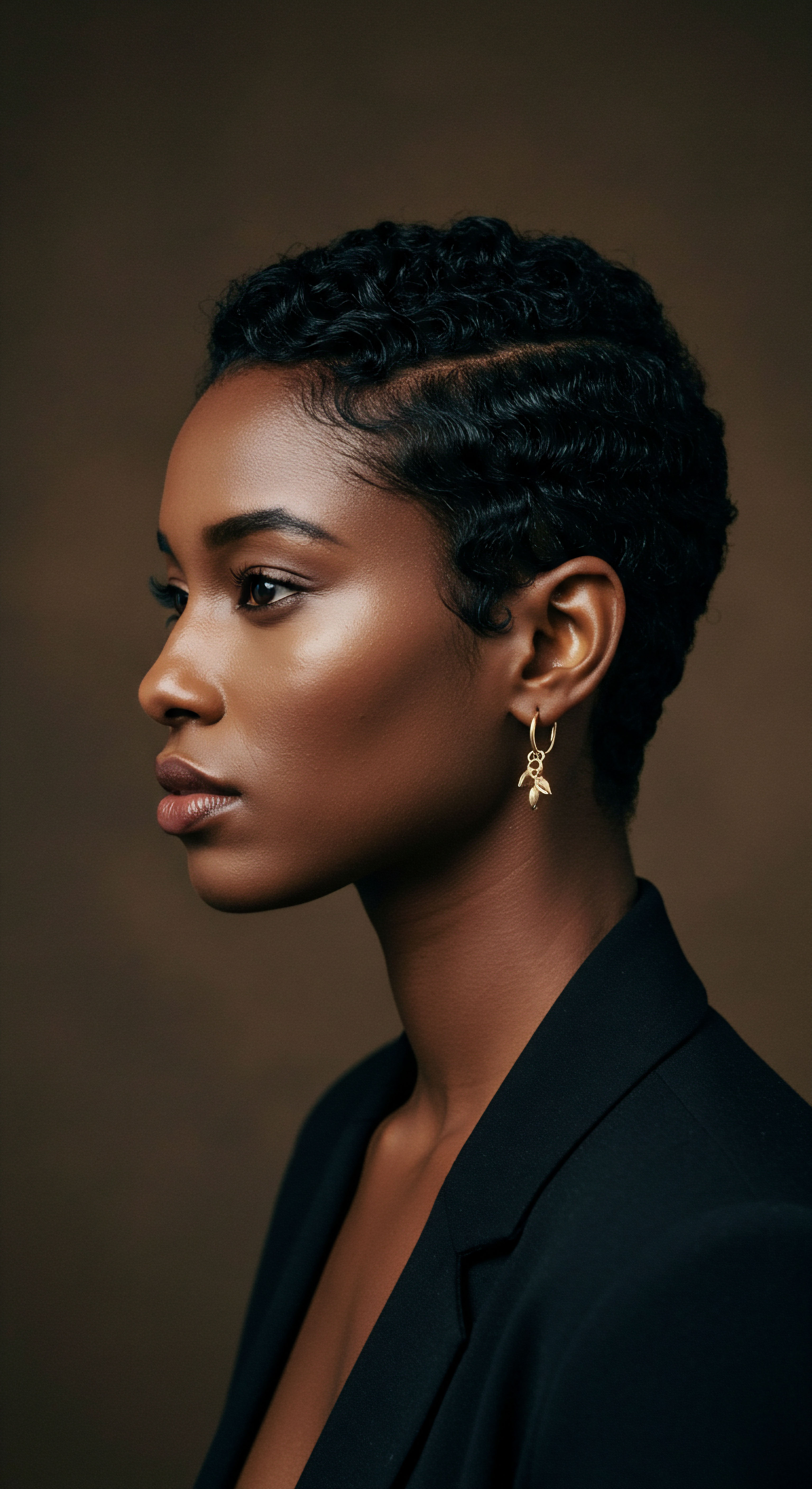
Roots
The whisper of ancient sands carries stories, not just of pharaohs and pyramids, but of personal adornment, of hair styled with purpose and artistry. For us, in our modern world, the idea of a wig might conjure images of theatricality or a quick change, yet in ancient Kemet, the land we now call Egypt, these crowning glories held a deeper, more abiding presence. They were more than mere accessories; they represented a confluence of hygiene, social standing, and aesthetic expression. To truly appreciate the meticulous craftsmanship and the thoughtful selection of elements that shaped these remarkable headpieces, one must look beyond the surface, seeking the very fibers that gave them life.
The dry climate of ancient Egypt, a benevolent preserver, has allowed us to witness these creations firsthand, offering tangible evidence of a culture deeply attuned to outward presentation. From the earliest known extensions dating back to approximately 3400 BC, found in a burial at Hierakonpolis, the practice of adorning oneself with false hair was established. These initial extensions hint at a tradition that would grow in complexity and significance, becoming an indelible mark of Egyptian identity. The materials chosen were not arbitrary; they were selected for their availability, their properties, and their ability to be transformed into works of wearable art.

What Were the Primary Elements of Ancient Egyptian Wigs?
The foundations of ancient Egyptian wigs rested upon a few principal elements, each contributing to their structure, appearance, and longevity. Foremost among these was Human Hair, a resource that held significant value within the economy of the time. Accounts from Kahun, an ancient town, place the worth of human hair in a category akin to gold, underscoring its precious nature. This esteemed material formed the bulk of many wigs, particularly those belonging to the elite, offering a natural texture and sheen that was highly prized.
Beyond human hair, the ingenuity of ancient Egyptian wigmakers extended to incorporating various plant fibers. These botanical additions served both practical and aesthetic functions, allowing for variations in cost, volume, and stylistic effect. Linen, derived from the flax plant, was a common textile throughout Egypt, known for its coolness and breathability. Its fibers, when spun and prepared, could be integrated into wigs, either as a base netting or as filler to add body.
Another prevalent plant material was Date Palm Fiber, often employed as an internal padding to give wigs their impressive dimensions, particularly for larger, ceremonial pieces. Papyrus plants also lent their fibers to wig creation, especially for those of more modest means.
Animal fibers also played a role, though perhaps less frequently than human hair or plant materials. Sheep’s Wool, despite being considered impure in some contexts and generally forbidden in temples for clothing, found its place in wig construction. It provided an alternative, often more accessible, material for wig production, allowing a broader spectrum of society to participate in the practice of wig wearing. Horsehair, introduced to Egypt later during the Second Intermediate Period with the Hyksos, also began to see use in wig manufacture, broadening the palette of available fibers.
Ancient Egyptian wigs, more than mere fashion, were carefully crafted statements of status and hygiene, built from human hair, plant fibers, and animal wool.

How Did Ancient Egyptians Prepare Hair and Fibers?
The preparation of these raw materials was a meticulous process, indicative of the high regard for wig artistry. Collected human hair, a commodity often acquired through trade or even from the client themselves, underwent thorough cleaning to remove any impurities, including the ubiquitous lice eggs. Once cleansed, the hair was separated into hundreds of individual lengths, each containing a considerable number of strands—a British Museum wig, for example, contains approximately 400 hairs per length, with some 300 such lengths overall. This precise division allowed for consistent application and styling.
Plant and animal fibers would have undergone similar preparatory steps, likely involving cleaning, straightening, and perhaps even some form of softening or conditioning to make them pliable for wig construction. The goal was always to achieve a material that could be manipulated into the desired form and held securely.
The choice of material often reflected the wearer’s social standing. The finest wigs, reserved for the elite, were composed entirely of human hair. For the middle class, a blended wig, combining human hair with vegetable fibers, provided a more attainable option.
The most economical wigs were constructed solely from vegetable fibers, making the practice of wig wearing accessible across different economic strata. This tiered approach to materials highlights the widespread acceptance and desire for wigs across Egyptian society.
| Material Category Human Hair |
| Specific Examples Donated, traded, or sold hair |
| Associated Social Class Elite, highest status |
| Material Category Plant Fibers |
| Specific Examples Linen, date palm fiber, papyrus |
| Associated Social Class Middle to lower classes, or as filler for elite wigs |
| Material Category Animal Fibers |
| Specific Examples Sheep's wool, horsehair |
| Associated Social Class Middle to lower classes, sometimes blended |
| Material Category Adhesives/Styling Agents |
| Specific Examples Beeswax, conifer resin, animal fat |
| Associated Social Class All classes (used for construction and styling) |

Ritual
Stepping from the foundational elements into the applied knowledge of ancient Egyptian wig craft, we uncover not just techniques, but a profound understanding of hair as a medium for expression and well-being. The daily and ceremonial practices surrounding these hairpieces speak to a culture that valued order, cleanliness, and a carefully curated appearance. The way these wigs were brought to life, from raw materials to sculpted forms, reveals a blend of artistry and practical wisdom that continues to resonate.
The creation of an ancient Egyptian wig was a testament to skilled hands and patient dedication. These were not quickly assembled items; they were meticulously built. The process typically began with the construction of a Foundation Base, often a fine netting made from plaited human hair itself.
This mesh provided the underlying structure, a framework upon which thousands of individual hair strands or fiber bundles would be secured. The precise layering of horizontal and vertical plaited lengths created a stable, yet breathable, cap, allowing for heat to escape the head, a practical consideration in Egypt’s warm climate.

How Were Wig Strands Secured and Styled?
Once the foundation was ready, the individual lengths of hair or fiber, carefully prepared and cleaned, were attached. This attachment was achieved through a clever combination of looping and binding, often aided by a warming mixture of beeswax and conifer resin. Approximately 2.5 cm of each hair strand would be looped around the foundation, then pressed back into the softened wax on the strand itself. A thin sub-strand, often made of fifteen individual hairs, would then be wound around this to ensure a secure attachment.
As the wax and resin cooled, they hardened, firmly setting the hair in place. The melting point of beeswax, between 60°C and 65°C, made this mixture remarkably effective, even in the extreme Egyptian heat.
This setting mixture served a dual purpose ❉ it acted as an adhesive, holding the intricate styles, and also provided a lustrous sheen to the finished wig. The craftsmanship involved was considerable; some researchers estimate that creating a complex wig could require up to 200 hours of work, particularly if plaits were styled directly on the wooden wig mount, a practice likely common in ancient times. This labor-intensive process further underscores the value and status associated with these hairpieces.
- Base Netting ❉ A finely plaited mesh, often of human hair, formed the initial cap.
- Hair Attachment ❉ Individual hair lengths were looped and secured using beeswax and resin.
- Styling Application ❉ Curls, braids, and waves were formed and held with the same resinous mixture.

What Methods Did Egyptians Use to Maintain Their Wigs?
The investment in a wig, particularly for the elite, extended beyond its initial creation to its ongoing care. These valuable possessions were not simply discarded; they were meticulously maintained to prolong their life and preserve their appearance. A significant aspect of wig care was the inability to wash them in the traditional sense, as water would dissolve the wax and resin setting agents.
Instead, wigs were perfumed to keep them fresh and pleasant-smelling. Scented petals, essential oils, and wood chips like cinnamon bark were used for this purpose.
To maintain the wig’s sheen and suppleness, oils and emollients derived from animal or vegetable fats were regularly applied. These conditioning treatments helped to keep the hair looking vibrant and well-kept. When not in use, wigs were stored with care, often placed in special boxes or on stands, sometimes even buried with their owners in tombs, reflecting a belief in their continued importance in the afterlife.
The careful preservation of ancient wigs, using beeswax and resins, highlights a sophisticated understanding of material science, ensuring their longevity and appearance for millennia.
The meticulous attention to wig care and maintenance reflects a society that placed high importance on personal presentation and hygiene. Wigs served as a practical solution to the challenges of living in a hot, arid climate, offering protection from the sun and reducing the incidence of head lice, as they could be removed and aired. For priests, who often shaved their heads for ritual purity, wigs offered a way to maintain an elegant appearance while adhering to their religious practices.
The variety of wig styles also speaks to a dynamic fashion sense that evolved over millennia. From the short, curled styles of the Old Kingdom to the more voluminous, elaborate creations of the Middle and New Kingdoms, wigs were a canvas for personal and societal expression. Men’s wigs often featured shorter, more structured styles, while women frequently adorned longer, more intricate arrangements of curls and plaits.
The “duplex” style, with its distinct sections of curls and plaits, was common for male officials during the 14th century BC, as evidenced by a well-known British Museum wig. Queen Nefertiti, a figure synonymous with Egyptian beauty, is even said to have favored dark blue wigs, a departure from the more common deep black or blonde shades.
These practices demonstrate that wigs were not merely decorative items. They were deeply integrated into the daily lives and cultural rituals of ancient Egyptians, serving as symbols of social standing, markers of personal identity, and tools for maintaining a desired aesthetic and hygienic standard. The preservation of these artifacts allows us a rare glimpse into the intimate world of ancient Egyptian self-care and expression.

Relay
Consider the silent language of ancient artifacts, the whispers they carry across millennia, inviting us to decode the intricate relationship between material, culture, and human aspiration. When we consider the materials that shaped ancient Egyptian wigs, we move beyond simple identification to a deeper exploration of societal values, scientific understanding, and the surprising echoes of modern concerns within a distant past. How did these seemingly humble materials—hair, plant fibers, animal fats—become instruments of power, purity, and enduring beauty? This inquiry leads us into a space where archaeology, chemistry, and social history converge, revealing complexities often overlooked in a casual glance.
The very composition of ancient Egyptian wigs, particularly the adhesives and setting agents, provides a fascinating window into their practical chemistry. Researchers have meticulously analyzed the residues found on preserved wigs, confirming the consistent use of beeswax and various resins, often conifer resin, as the primary fixatives. This choice was not accidental.
Beeswax, with its relatively high melting point, ensured that the elaborate styles remained intact even under the scorching Egyptian sun. The addition of resin likely enhanced its adhesive properties and perhaps contributed to the sheen of the finished hairpiece.

What Chemical Analyses Reveal About Wig Adhesives?
Scientific investigations, such as those conducted by researchers at the University of Manchester, have further illuminated the chemical makeup of ancient Egyptian hair treatments. A study examining hair from 18 mummies, predominantly from the early Ptolemaic Period, revealed the presence of an unknown substance on the hair of nine individuals. Subsequent chemical analysis identified this substance as being composed of Fatty Acids of Animal and Plant Origin.
While this particular finding related to natural hair, it aligns with broader evidence of animal and vegetable fats being used as emollients and styling agents for wigs, indicating a sophisticated, albeit empirical, understanding of lipid chemistry for cosmetic purposes. The presence of these fatty compounds suggests a deliberate effort to condition and preserve hair, whether natural or artificial, reflecting a continuity in care practices.
The social stratification inherent in the materials used for wigs also offers a compelling point of study. While the elite proudly displayed wigs crafted entirely from human hair, often adorned with precious metals and jewels, the lower classes utilized more readily available plant fibers or sheep’s wool. This distinction was not merely a matter of economic capacity; it was a visible manifestation of social standing, a silent yet powerful declaration of one’s place within the societal hierarchy. The value of human hair, comparable to gold in some ancient accounts, underscores the economic power required to acquire and maintain such a status symbol.
Consider the case of Queen Isimkheb, from approximately 900 BC, whose wig, now housed in the Cairo Museum, was so massive and heavy that she reportedly required assistance from her attendants to stand. This extraordinary example, made of brown human hair held together by beeswax, serves as a tangible representation of the lengths to which the elite would go to express their status through hair adornment. The sheer volume and weight of such a piece, while perhaps impractical by modern standards, was a clear demonstration of wealth and access to skilled labor and precious materials.
Ancient Egyptian wigs, meticulously constructed from human hair, plant fibers, and animal wool, symbolize a complex interplay of status, hygiene, and cultural identity.
The cultural and religious significance of wigs further deepens our understanding. Beyond their aesthetic and hygienic functions, wigs played a role in expressions of ritual purity. Priests, for instance, maintained shaved bodies to guard against impurities, yet still wore wigs, signifying their adherence to both practical cleanliness and an idealized aesthetic.
The association of certain wig styles with deities, such as the bouffant style linked to Hathor, the goddess of beauty, highlights the spiritual dimensions of hair and adornment in ancient Egyptian belief systems. Hair, in this context, was not just a biological outgrowth; it was a conduit for identity, social information, and even religious meaning.

Did Ancient Egyptians Dye Their Wigs or Natural Hair?
While the natural color of most human hair used in wigs was likely dark, artistic representations sometimes depict wigs in deep black, or even vibrant shades of blue, red, or green, particularly for royalty. This raises the question of whether wigs themselves were dyed, or if these colors were achieved through other means, such as colored strands incorporated into the wig, or through artistic convention. Evidence suggests that ancient Egyptians did use natural dyes, such as Henna, to color their own hair, primarily to conceal graying. It is plausible that similar techniques, or the incorporation of pre-dyed fibers, could have been applied to wigs to achieve desired hues, further enhancing their visual impact and reflecting evolving fashion sensibilities.
The study of ancient Egyptian wigs extends beyond their physical composition to their broader implications for understanding ancient societies. They provide a lens through which to view not only beauty standards and hygiene practices but also economic structures, social hierarchies, and religious beliefs. The sheer quantity of hair required for some of these elaborate pieces, such as the one in the British Museum with its approximately 120,000 individual hairs, hints at a well-organized system for acquiring and processing human hair. This speaks to a society capable of supporting specialized wig-making workshops and a trade in human hair, placing it alongside other valuable commodities.
- Human Hair as a Commodity ❉ Ancient accounts placed human hair’s worth on par with gold, indicating its economic value.
- Chemical Fixatives ❉ Beeswax and conifer resin were consistently used to secure and style wigs, proving effective in the hot climate.
- Social Stratification ❉ Material choice, from pure human hair to plant fibers, directly correlated with the wearer’s social standing.
The remarkable preservation of many ancient Egyptian wigs, allowing for detailed archaeological and chemical analysis, offers a unique opportunity to connect with the past. These artifacts, often found in tombs alongside their owners, underscore the belief that personal appearance, including elaborate hairstyles, was significant even in the afterlife. The enduring presence of these hairpieces in museum collections today is a testament to the skill of ancient artisans and the lasting cultural importance of hair in ancient Egypt.
| Component Foundation Base |
| Primary Function Structural support, breathability |
| Materials Often Used Plaited human hair, sometimes linen netting |
| Component Hair Strands/Bundles |
| Primary Function Primary aesthetic material, volume |
| Materials Often Used Human hair, sheep's wool, plant fibers (linen, palm, papyrus) |
| Component Setting Agent |
| Primary Function Holds style, provides sheen, adhesive |
| Materials Often Used Beeswax, conifer resin, animal fats |
| Component Adornments |
| Primary Function Decoration, status display |
| Materials Often Used Gold rings, jewelry chains, pins, ribbons, tassels, flowers, tiaras |
| Component These components combined to create the diverse and elaborate wigs of ancient Egypt. |

Reflection
As we close our exploration into the materials that formed ancient Egyptian wigs, we are left with more than just a list of ingredients. We gain a sense of the profound human desire for order, beauty, and expression, a desire that transcends time and culture. The Egyptians, with their meticulous craft and thoughtful selection of resources, remind us that hair, in all its forms, has always held a mirror to society, reflecting status, hygiene, and a deep connection to identity. The enduring presence of these ancient hairpieces in our museums today is not simply a display of historical curiosities; it is a gentle invitation to consider the continuous thread of human ingenuity and our shared longing for personal presentation, a silent conversation between past and present.

References
- Cox, J. Stevens. “A Note on the Wig from Thebes in the British Museum.” The Journal of Egyptian Archaeology 63 (1977) ❉ 67-70.
- Fletcher, Joann. “Ancient Egyptian Hair ❉ A Study in Style, Symbolism and Significance.” PhD diss. University of Manchester, 1994.
- Fletcher, Joann. “Hair, Wigs and Hair Extensions in Ancient Egypt.” In Ancient Egyptian Materials and Technology, edited by Paul T. Nicholson and Ian Shaw, 495-502. Cambridge ❉ Cambridge University Press, 2000.
- Fletcher, Joann. “The Ancient Adornments Project ❉ Hair and Wigs in Ancient Egypt.” Internet Archaeology 42 (2016).
- Fletcher, Joann, and Filippo Salamone. “An Ancient Egyptian Wig ❉ Construction and Reconstruction.” Internet Archaeology 42 (2016).
- Freed, Rita E. Ramesses the Great. Boston ❉ Museum of Fine Arts, 1982.
- Quirke, Stephen, and Jeffrey Spencer. The British Museum Book of Ancient Egypt. London ❉ British Museum Press, 1992.
- Shaw, Ian, and Paul T. Nicholson. The British Museum Dictionary of Ancient Egypt. London ❉ British Museum Press, 1995.
- Strudwick, Nigel. Masterpieces of Ancient Egypt. London ❉ British Museum Press, 2006.
- Taylor, John H. and Daniel Antoine. Ancient Lives, New Discoveries ❉ Egyptian Mummies from the British Museum. London ❉ British Museum Press, 2014.